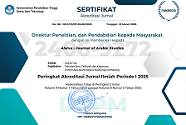Al-Mushkilāt fī al-Tamyīz bayna al-Tarkīb al-Iḍāfī wa-al-Tarkīb al-Naʿtī fī al-Qirā’ah li-Ṭalabat al-Jāmiʿah
DOI:
https://doi.org/10.21580/alsina.4.1.4212Keywords:
Adjective structures, grammatical problems, phrase structures, reading skillAbstract
There are still many students in the Arabic Language Teaching Department at Walisongo State Islamic University Semarang who still face the difficulty of distinguishing between phrase and adjective structures in reading skill. There must be many reasons that cause difficulties and problems in distinguishing between phrase and adjective structures. The objectives of this research are: To find out the causes of problems in distinguishing between phrase and adjective structures in reading skill for students of the Arabic Language Teaching Department in 2017 at Walisongo State Islamic University Semarang and to know the appropriate solutions to overcome the problems. The researcher held a survey study with the statistical community of all students of the Arabic Language Teaching Department in 2017, with a number of 70 students. The researcher used the test and interview to collect data. The results of this research are that one of the reasons for its problems is the lack of control over the rules of auxiliary structure and the adjective structure and the differences between them, the lack of practice in determining the phrase and adjective structures and distinguishing between them in Arabic texts, the lack of practice in reading Arabic texts that contain the phrase and adjective structures, the lack of vocabulary, and the lack of understanding Vocabulary Genres. As for the solutions to the problems, they are supposed to the understand the rules of phrase and adjective structures and the differences between them, a lot of practice in identifying and differentiating between them in Arabic texts, more rehearsing in reading Arabic texts, a lot of reading Arabic texts so that students get a lot of vocabulary, and a lot of understanding the types of vocabulary.
Downloads
References
Al-Ashmūnī, ʻAlī ibn Muḥammad. Sharḥ al-Ashmūnī ʻalá Alfīyat Ibn Mālik. Beirut: Dār al-Kutub al-ʻIlmīyah, 2010.
Bernikova, Olga, and Oleg Redkin. “Linguistics and Islamic Studies in Historical Perspective: The Case of Interdisciplinary Communication.” In IMCIC 2017 - 8th International Multi-Conference on Complexity, Informatics and Cybernetics, Proceedings, 2017–March:311–15. Orlando, Florida, USA, 2017. https://www.iiis.org/CDs2017/CD2017Spring/papers/ZA417IN.pdf.
Brosh, Hezi. “Grammar in the Arabic Language Classroom: Perceptions and Preferences.” Al-’Arabiyya 50 (2017): 25–52. http://www.jstor.org/stable/26451395.
Dajani, Basma Ahmad Sedki, Salwa Mubaideen, and Fatima Mohammad Amin Omari. “Difficulties of Learning Arabic for Non-Native Speakers.” Procedia - Social and Behavioral Sciences 114 (2014): 919–26. https://doi.org/10.1016/j.sbspro.2013.12.808.
Didouh, Omar, and Mohammed Bouazzi. “Difficulties Facing Non-Native Speakers in Learning the Arabic Language.” Majallat Al-Nāṭiqīn Bi-Ghayr Al-Lughah Al-ʿArabīyah 1, no. 1 (2017): 144–65. https://doi.org/10.21608/jnal.2017.44500.
Elnaggar, Khaled Mohammed. “Difficulties in Learning Arabic for Non-Native Speakers Islamic University in Medina.” International Journal of Research in Educational Sciences 2, no. 4 (2019): 289–354. https://doi.org/10.29009/ijres.2.4.7.
Fakhruddin, Ahmad. Quantum Reading Book: Cara Cepat Membaca Kitab 6 Jam Langsung Praktek. Depok: Duta Grafika Nusantara, 2009.
Ghalāyīnī, Muṣṭafá. Jāmiʻ Al-Durūs Al-ʻArabīyah. Beirut: Al-Maktabah al-ʻAṣrīyah, 1987.
Haleem, Muhammad A S Abdel. “46. Arabic as the Language of Islam.” In The Semitic Languages: An International Handbook, edited by Stefan Weninger, 811–17. Berlin, Boston: De Gruyter Mouton, 2011. https://doi.org/doi:10.1515/9783110251586.811.
Hāshimī, Al-Sayyid Aḥmad. Al-Qawāiʿd Al-Asāsīyah Lil-Lughah Al-ʿArabīyah. Jakarta: Dinamika Berkah Utama, 1354.
ʻAṭā, Ibrāhīm Muḥammad. Ṭuruq Tadrīs Al-Lughah Al-ʻArabīyah Wa-Al-Tarbiyah Al-Dīnīyah. Cairo: Maktabat al-Nahḍah al-Miṣrīyah, 1996.
Ibn Hishām, ʻAbd Allāh Ibn Yūsuf. Awḍaḥ al-Masālik ilá Alfīyat Ibn Mālik. Beirut: Al-Maktabah al-ʻAṣrīyah, 2005.
Ibrāhīm, ʻAbd al-ʻAlīm. Al-Muwajjah Al-Fannī Li-Mudarrisī Al-Lughah Al-ʻArabīyah. Cairo: Dār al-ʻUlūm, 1966.
Idris, Mardjoko. Tata Bahasa Arab (Bagi Pemula). Yogyakarta: Belukar, 2009.
Istiqomah, Himatul, and Hanik Mahliatussikah. “Musykilat Al-Tarbiyyah Tuwajihuha Al-Thalabah Fi Ta’allum Al-Lughah Al-Arabiyah Li Ghairi Al-Nathiqin Biha.” Jurnal Al-Bayan: Jurnal Jurusan Pendidikan Bahasa Arab 11, no. 2 (2019): 254–80. https://doi.org/10.24042/albayan.v11i2.5257.
Jārim, ʻAlī, and Muṣṭafá Amīn. Al-Naḥw al-Wāḍiḥ. Surabaya: Balai Buku, n.d.
Masrupi, Masrupi, Nurul Murtadho, and Ibnu Samsul Huda. “Mushkilāt Ta‘līmi Al-Lughah Al-‘Arabiyyah Fī Thailand Wa Al-Ḥulūl ‘Alaiha.” Alsina : Journal of Arabic Studies 2, no. 1 (2020): 19. https://doi.org/10.21580/alsina.2.1.5395.
Setiyawan, Agung. “Problematika Keragaman Latar Belakang Pendidikan Mahasiswa Dan Kebijakan Program Pembelajaran Bahasa Arab.” Arabiyat : Jurnal Pendidikan Bahasa Arab Dan Kebahasaaraban 5, no. 2 (2018): 195–213. https://doi.org/10.15408/A.V5I2.6803.
Shamsuddin, Salahuddin Mohd., and Siti Sara Binti Hj. Ahmad. “Problems of Teaching Arabic Language to Non-Native Speakers and Its Methodological Solutions.” Advances in Social Sciences Research Journal 6, no. 6 (2019). https://doi.org/10.14738/assrj.66.6710.
Sieny, Mahmoud Esmaʼil, Nāṣif Muṣṭafá ʻAbd Al-ʻAzīz, and Mukhtār Al-Ṭāhir Ḥusayn. Al-ʻArabīyah lil-Nāshiʼīn: Manhaj Mutakāmil li-Ghayr al-Nāṭiqīn bi-al-ʻArabīyah. Riyadh: Wizārat al-Maʻārif, 1983.
Toemah, Roushdy A. Taʿlīm Al-ʿArabīyah Li-Ghayr Al-Nāṭiqīn Bihā: Manāhijuhū Wa-Asālībuhū. Rabat: ICESCO, 1989.
Downloads
Published
How to Cite
Issue
Section
License
Copyright
The copyright of the received article shall be assigned to the publisher of the journal. The intended copyright includes the right to publish the article in various forms (including reprints). The journal maintains the publishing rights to published articles. Authors are allowed to use their articles for any legal purposes deemed necessary without written permission from the journal, but with an acknowledgment to this journal of initial publication.
Licensing
In order for Alsina: Journal of Arabic Studies to publish and distribute research articles, the editors need publishing rights (transferred from author to publisher). This agreement relates to the transfer/publishing copyright license to Alsina: Journal of Arabic Studies but the authors still have significant rights to use and share their published articles.
Alsina: Journal of Arabic Studies supports the need for writers to share, disseminate and maximize the impact of their research and their rights on any database. As a journal article writer, you have the right to various uses of your articles, including that by the institution or company where you work. Copyright can be used without the need for special permission. Authors who publish articles in the Alsina: Journal of Arabic Studies have broad rights to use their work for teaching and scientific purposes without requesting permission, including:
- Use by the author for lectures, presentations, or conferences, with distribution of copies to participants;
- Distribution to colleagues for research use;
- Use in compilations of the author's subsequent work;
- inclusion in a thesis or dissertation;
- Reuse of sections or excerpts from articles in other works (with full acknowledgment of the final article);
- Preparation of derivative works (other than commercial purposes) (with full acknowledgment of the final article);
- Voluntary posting on open websites operated by authors’ or writers' agencies for scientific purposes
When submitting a manuscript, authors do so on the understanding that if accepted for publication, the copyright for publishing (publishing right) of the article shall be assigned/transferred to Alsina: Journal of Arabic Studies.
Authors whose articles are accepted for publication will receive confirmation via email and sent a Copyright Transfer Agreement.


 Accreditation
Accreditation 
 In Collaboration with
In Collaboration with 

 Visitors
Visitors  Article Template
Article Template





